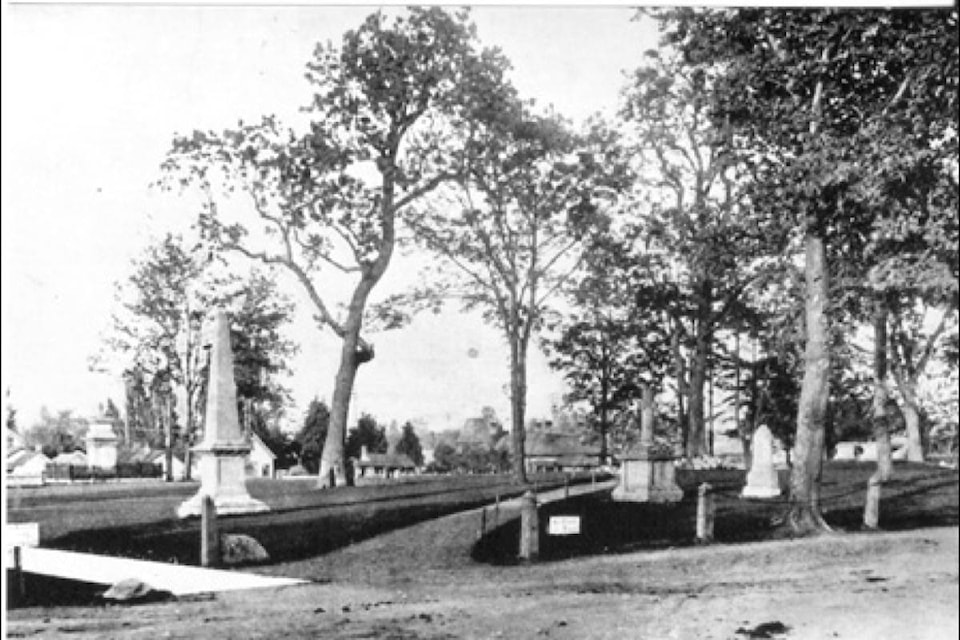“The stench and effluvia is so great that the sexton…had to consume an unwonted amount of tobacco to enable him…to complete the necessary excavation…”—the Rev. J.B. Good, 1861.
You wouldn’t think that a public cemetery would need to be reinvented but, in the case of Victoria’s Pioneer Square, aka the Old Burying Ground aka Quadra Street Cemetery, it has been rejigged not once but twice.
Today a small rectangular park adjacent to Christ Church Cathedral, to quote the City of Victoria, what began as the city’s second cemetery served as such for just 18 years, 1855-1873. The headstones, or most of them, are still there but most have been repositioned to allow for lawn, sidewalks, benches and trees, and just a few of the larger examples of the monument makers’ art remain in situ.
In other words, the exact locations of most of the 1,300 graves are now unknown. Make no mistake: when you visit Pioneer Square, you walk over these pioneers’ final resting places. Ah, progress…
The sad fact is, though, even when used as a cemetery, the Old Burying Ground suffered from neglect that hastened its being replaced by Ross Bay Cemetery which remains in service.
As far back as May 1861, when just six years old, the pioneer cemetery was an affront to the eyes and to the nostrils, as the Rev. J.B. Good informed Colonist readers in a blistering letter. New to Victoria, he’d been asked to conduct a burial service and, while waiting for the coffin and cortege to arrive, “employed the time of suspense in a careful survey” of his surroundings.
He was appalled by what he saw and smelled and, after several days’ reflection, he let loose with both barrels in a letter to the Colonist: “…I unhesitatingly pronounce [the cemetery] to be worthy of a distinguished place in the catalogue of public nuisances”. The cemetery, he raged, made itself felt “in a manner startling to some other senses than the olfactory of those whose fate it is to live in its more immediate neighbourhood.”
He graciously chose to ignore “the promiscuous way in which Heathens and Christians jostle each other, so to speak, in their silent places,” and the general neglect of the occupied graves. Rather, after comparing Victoria’s burial ground to others on the Pacific Coast, he confined himself to “scientific and sanitary grounds.”
The single worst factor, he believed, was the sloping ground which allowed rain water to drain northward from the occupied area (obviously the higher ground had been claimed first) to the lower, yet unoccupied ground. Meaning that, “You have only to open [dig] a grave in winter in the lower part to find out the mischief. The stench and effluvia is so great that the sexton [of next-door Christ Church Cathedral] declares he had to consume an unwonted amount of tobacco to enable him at all to complete the necessary excavation…”
Rev. Good went on in graphic description but you get the drift. In short, he wanted the cemetery closed, a new one established “at a safe distance” from sight and scent.
He wasn’t alone in this view, others suggesting as early as 1863 that it be closed and (prophetically) made into a park “planted with various ornamental and shade trees”. Closed in 1873, it did become a park in 1908 after decades of neglect that bordered on sacrilege and vandalism. It was the city that moved most of the smaller headstones to the back of the property to create grassland, thereby losing their correct positions.
Four years ago, city council approved a plan to “preserve and enhance the rich historic value of the park’s cemetery while maintaining a park space that suits the needs of the surrounding community”. This included preservation of eight of the larger tombstones and those which had been moved to the east fenceline years before. Some of the headstones, of course, are in better condition than others and some will be “preserved as joint fundraising efforts with community partners arise”.
Pathways were repaired and widened to increase accessibility by wheelchairs, scooters and strollers. Even benches, lighting and garbage bins were replaced with “new stylized furnishings that better reflect the park’s history”. Five invasive holly trees were removed as was an English yew for safety reasons, replaced with an evergreen (native, no doubt) hedge.
This TLC for Pioneer Square was long overdue. Obviously, the damage done by the moving of the headstones can’t be undone. We have the Old Cemetery Society to thank for their years of efforts in researching the 1,300-odd pioneers (among them some of the city’s most illustrious pioneers and British naval officers and seamen) who are interred here.
www.twpaterson.com
